50 Years of THON
From humble beginnings in the HUB Ballroom to the multimillion-dollar phenomenon it has become, THON alums take us through the evolution of the world’s largest student-run philanthropy.
Charles Millard: Chris was amazing. He dealt with cancer for two and a half years, and he was a brave soul. He was in the hospital in Hershey for 45 days or so before he died [on Dec. 17, 1972], and we decided something should happen there like the Jimmy Fund. That’s why we started The Children’s Fund. We started it the day he died. A few years later, the medical center got an officer of gifts and endowments named Herb Kraybill ‘47 Edu, and he read Chris’ story about the four diamonds. It was his idea to rename it the Four Diamonds Fund.
In the winter of 1973, while the Millards were grieving for their son, a handful of students at University Park were planning a new fundraiser that Interfraternity Council president Bill Lear ’73 Sci hoped would showcase the Greek system’s philanthropic nature. The movie They Shoot Horses, Don’t They, which featured a Depression-era dance marathon, had opened in theaters in 1969, sparking the idea for an endurance-based competition in which student couples would compete in a 30-hour dance marathon in the HUB Ballroom, with all proceeds going to help children in need. Mel Klein ’67, ’71 DEd Edu was assistant dean of men for fraternity affairs and oversaw events at the HUB at the time.
Klein: Did I ever think it would turn into an event as it is today? No. It just developed its own momentum.
First-year student Cris Guenter ’76 Edu, ’76 BFA A&A was signed up for the marathon by her roommate, who went room to room in Leete Hall collecting money for the $10 entrance fee. Sam Walker ’75 H&HD was recruited to be Guenter’s partner. The two met for the first time on the dance floor on Feb. 2, 1973, when the Rolling Stones’ “Jumpin’ Jack Flash” jump-started 39 couples into a friendly contest of continuous motion.
Guenter: There were big glass jars on a table just off the dance floor, one for each couple, and we were given a number—we were couple No. 13. Everybody had a white T-shirt; silkscreened in black on the front side was “Interfraternity Council Dance Marathon.” They had Magic Markers there, and we wrote our own numbers on the front and back.
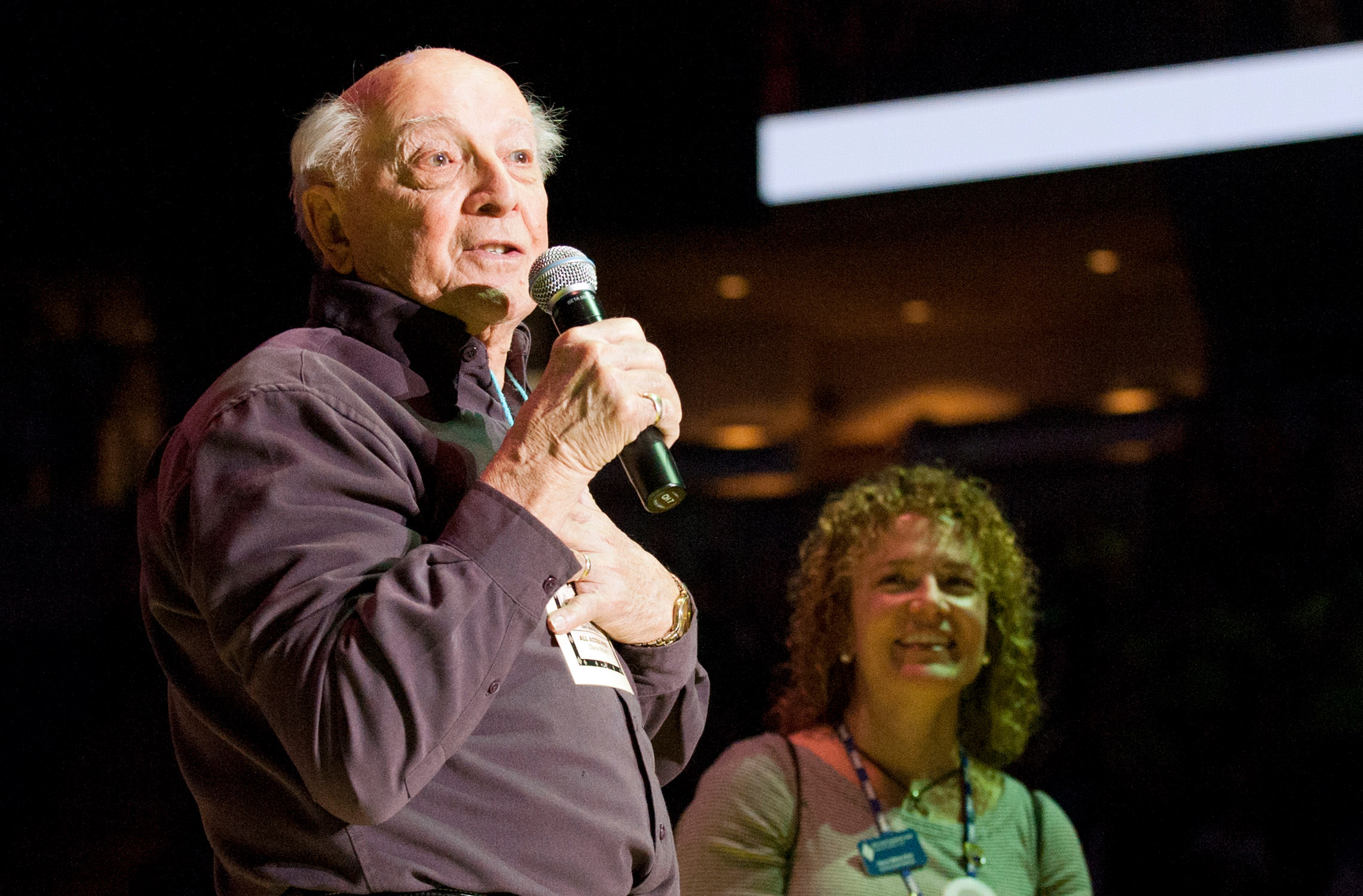
Klein: They had to keep moving. That was a requirement, and there were volunteers who would move throughout the dancers to make sure they were dancing, or at least moving in place. As the marathon went on there were couples and individuals who simply ran out of energy; they dropped out.
Guenter: You were judged on two things: the amount of money people donated for you, and the amount of time you spent on the dance floor. Sam and I took one bathroom break after 26 hours, and we were off the floor for 77 seconds. We both lost about 10 pounds just from dancing.
The early hours were fairly easy, Guenter says, as she and Walker got to know each other and the other participants, while bands played two-hour sets and people wandered in to see what was happening.
Don Mains ’76 Com: I remember as a freshman, I marveled walking by the HUB. You heard bands playing at 1 in the morning. I thought, ‘What is this?’ After that, it became a passion of people not only to dance, but to cheer people on.
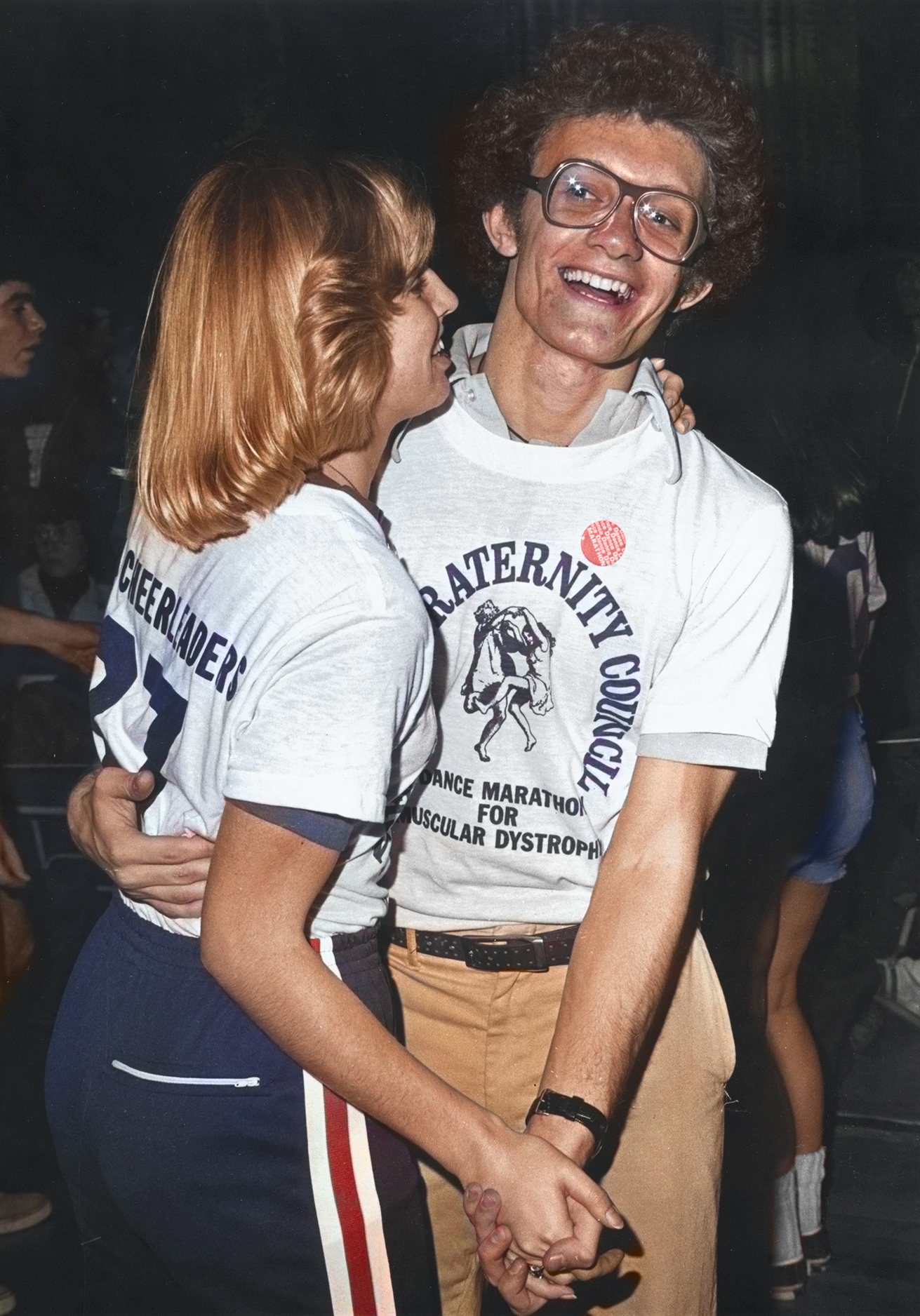
Klein: The dancers had a great deal of support from their friends, and from their fraternities, sororities, and other organizations. They would stop by and provide some morale, some snacks.
Guenter: As the hours wore on, it was more a sense of what can we do to keep ourselves preoccupied. The A&A students had gotten a piece of plywood, and they attached ropes to the four sides, so two couples could put the board in the middle, hanging from the ropes around our necks, and we could use it as a table to play cards while we kept our feet moving.
After 30 hours, only 17 couples remained on the floor, and a total of $2,136 had been raised for the Butler County Chapter of the Arc of Pennsylvania. Guenter and Walker were shocked to hear their names called as the winners.
Guenter: When they announced us, we were in the middle of the ballroom, and the crowds rushed and surrounded us. Our RAs picked us up and the crowd passed us, the way they pass the Nittany Lion, right up to the stage. That’s a memory I’ll never forget. I think we won $300—$150 each. I used my winnings to buy a record player for my dorm room.
The success of the first dance marathon inspired the IFC to up the ante in its second year, lengthening the event to 48 hours. Fifty-one couples accepted that challenge. Guenter was again among them; she danced all four years, finishing every time.
Guenter: Around 5 a.m. Sunday, when not many people were there, the band was trying to keep us going, and they asked for requests. We called out, “‘Here Comes the Sun’!” So they played that, and the sun was coming up, and I remember going, “OK. We made it.”
In Year 2, $10,825 was raised for the American Heart Association. The partnership of Delta Delta Delta and Kappa Delta Rho earned top fundraising honors with $1,633; they’d own the top spot for the next four years.
Klein: It was noticeably getting bigger. After its first run, like anything, you figure out some things. The PR was better, the posters were better, the T-shirts got better. Instead of “What is this?” it became, “Are you going to do it this year?”
Perhaps daunted by the 48-hour event, only 37 couples competed in 1975, raising more than $12,000 for Easter Seals; the winning couple spent just 55 seconds off the dance floor. In 1976, the IFC Dance Marathon got its first theme: “Dance for Those Who Can’t,” with $15,283 collected for the Muscular Dystrophy Association.
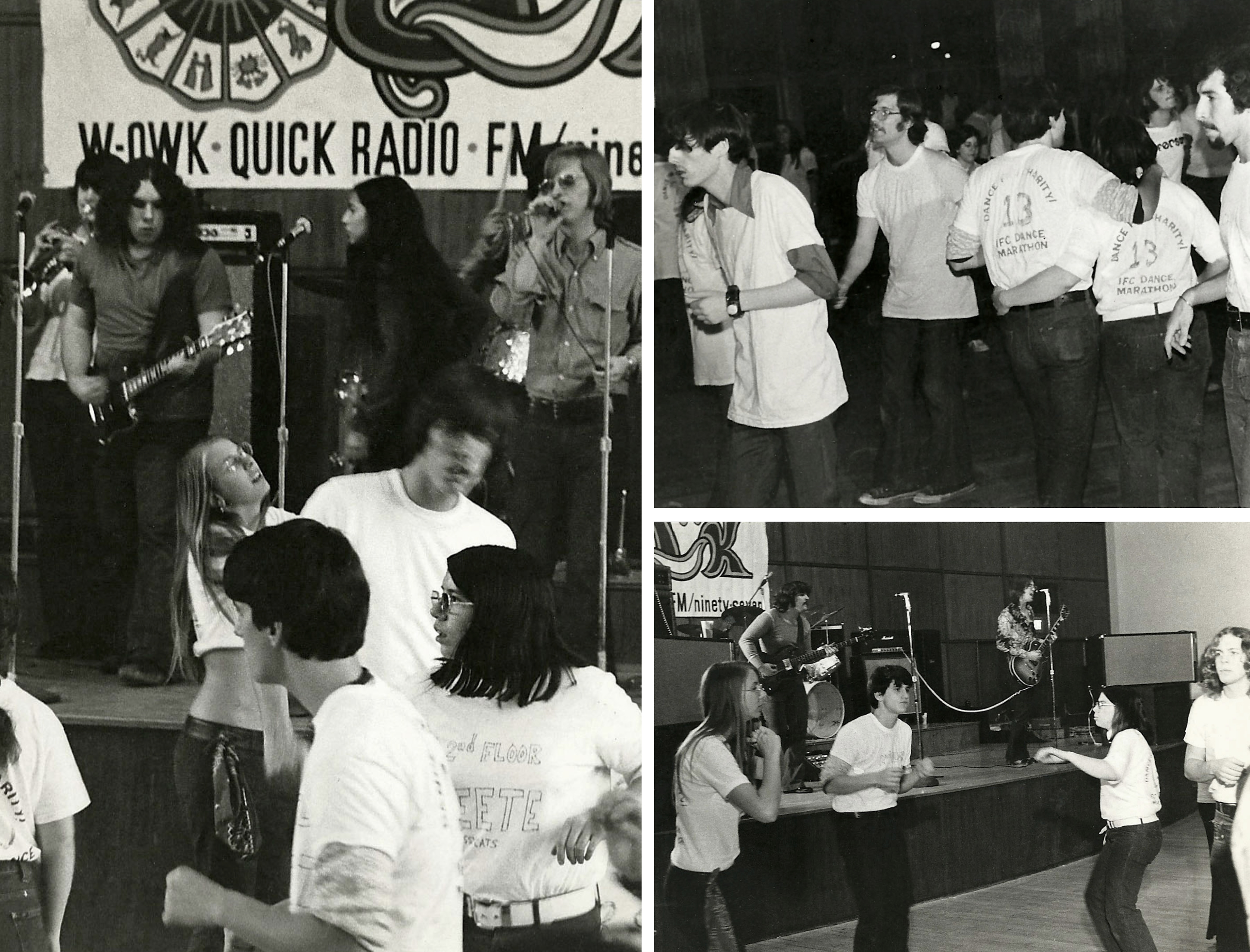
Millard: We came to Penn State in 1976 to witness their fundraiser. It was just a little dance they did at the HUB. They were changing every year to help all different charities, and we asked them to consider the Four Diamonds, which was in their medical school.
Mains: I was sitting across from the HUB one day, and I could hear a radio broadcast from the station that Penn State students ran, and the Hershey Medical Center’s Herb Kraybill had arranged for the student-run radio station to tell the story about a boy who had died of cancer and his story of a knight and four diamonds.
Mains was overall chairman of the IFC Dance Marathon in 1977, and he decided the Four Diamonds Fund would be the perfect recipient of that year’s efforts.
Mains: The chance to be part of a charity that was part of Penn State, I had the feeling that students would embrace it more and, in turn, I felt the administration would embrace the students’ idea. That began a wonderful relationship.
Millard: We were glad that they agreed to take us on for a year. We knew it was crucial to our start to have something as big as Penn State recognize us.
Klein: It took a tremendous amount of time to put together a dance marathon, particularly as it grew. The students worked extremely hard at putting together a program that not only would reflect positively on the sponsoring organizations and participants, but also on the good name of the university.
Rob Bickhart ’78 Lib: There were rules about fundraising, designated weekends where canning was permitted across the commonwealth, which was also a lot of fun. Crazy, but a lot of fun. I remember I had a conversation in my own chapter [of Sigma Alpha Epsilon] about sending out a letter to our alums to raise money. We just had to beat KDR.
In 1977, in a nod toward increased safety, dancers were required to take five three-minute breaks throughout the 48-hour marathon.
Bickhart: You’d run to the bathroom and come back and lie on these wrestling mats, and people had baby powder and would rub your legs, because of the chafing—you couldn’t just stand back then, you had to dance. It was brutal.
Sue Reich ’79 Sci: There were not as many bands as the first couple years, more radio stations, like QWIK Rock, playing music. But there was very little going on on the stage.
Bickhart: I remember my dance partner was totally delusional by Sunday at noon, and her sorority sisters came and took her away. I danced alone for the rest of the marathon.
The 1977 IFC Dance Marathon nearly doubled the fundraising total of the year before: $28,685 for the Four Diamonds Fund. For 1978, the overall committee tried a new tactic with co-chairs: Bickhart and Jimmy Cefalo ’78 Com, a star running back on the football team.
Bickhart: The marathon was in its infancy, and they were working hard to make it legitimate. They determined it might be best if we had a VIP in the mix. At the time Jimmy was a hotshot on campus; people really liked him. So they put us together, and Jimmy and I ended up being terrific friends.
Cefalo: I remember having a conversation with Joe Paterno about it. He looked up and said, “They shoot horses, don’t they?” I had to go figure out what he was talking about. But I think he liked the idea; he always enjoyed the idea of us getting involved with Penn State beyond football.
Bickhart: Until 1978 the dance marathon was really run by the IFC. It was all guys. And Jimmy and I believed we really needed to include the Panhellenic Council going forward. So I asked Jami McKeon ’78 Lib if she would come on board and be our comms person.
Rob Schmidt ’81 Com: Another seminal moment was the choice of the 1978 committee, after rotating charities for five years, to select the Four Diamonds Fund for the second straight year. A lot of people don’t realize that. They think, “Oh, they picked them in ’77 permanently.” No.
Bickhart: We pulled together a meeting at Old Main with Penn State Development and Herb Kraybill. And Jimmy and I interviewed Easter Seals and Muscular Dystrophy, and then we all got back together again and made the decision to go back to the Four Diamonds Fund, knowing full well that it would be hard to break from the Four Diamonds Fund after we’d done consecutive years. And I don’t regret that.
Millard: We were overwhelmed over the next few years as it mushroomed and grew so unexpectedly.
Reich: Two ideas came from a speech class I had with Bob Bickhart in the fall of 1977. We sat in the back, and I don’t think either one of us got an A, because we would sit back there and talk about Dance Marathon. So we’d just sit there and say, “What could we do to improve it?” One idea was for a morale group, and the other was to have medical on-site.
Bickhart: Sue had brought up the idea that we should be prepared for something, that if somebody was in trouble, what would happen? That’s when we decided to have EMS personnel at the marathon, and the Morale Pals.
Reich: Morale Pals came from having watched the year before. When it started getting into the second morning, people would start losing it. And there weren’t as many people who would come to support the dancers. They would get super emotional because they were so exhausted. I wanted to make sure there was somebody there. Morale Pals would be in a special T-shirt, and they would be there to help with anything, but mostly to keep spirits up.
The 1978 marathon, themed “Give Hope a Chance, Come On and Dance,” would be the last one held at the HUB: 56 couples entered, 28 lasted the entire 48 hours, and six participants were taken away by ambulance.
Bickhart: Saturday Night Fever had come out, and we hired dancers to come and teach disco dancing. We made all the dancers come the day before and learn the dance to “Night Fever.” We started off on Friday at 7 p.m. with the Saturday Night Fever dance, and they’d do it throughout the marathon.
Reich: I danced in 1978, and the shared commitment was overwhelmingly emotional. Somebody from Hershey Medical came and pepped people up a bit. You relied on your own will to keep going, and whatever friends came. I had friends come ’round-the-clock, and that I was so grateful for.
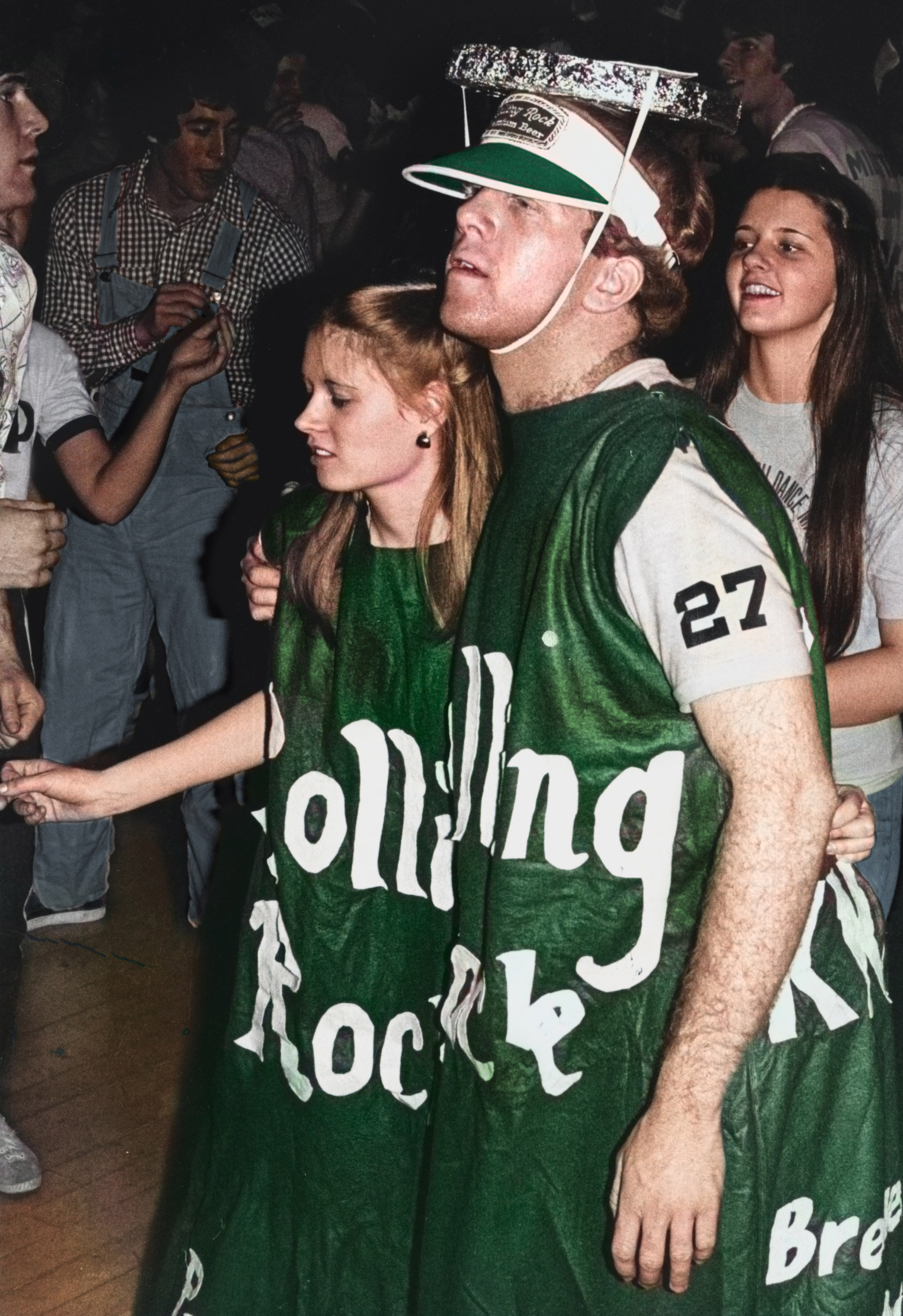
A record-breaking $52,818.69 was raised for the marathon’s two-time partner, Four Diamonds Fund. But a month later, celebration turned to tragedy for the overall committee.
Bickhart: We were headed to Hershey—we had been invited to go to a Hershey Bears hockey game as a thank-you from the Hershey Medical Center and the Four Diamonds Fund. We were so excited about what we had done. We were on 322 outside Harrisburg, and somebody came out of traffic heading toward us and we had a head-on collision. IFC vice president Kevin Steinberg died immediately.
Jim Adisey Jr. ’80 H&HD, ’80 Sci: I was driving. The guy who had gotten me involved in dance marathon was Kevin; we were fraternity brothers and very good friends.
Bob Buckhorn ’80 Lib: That was a huge loss for the dance marathon. Obviously, for us he was a KDR frat brother; Kevin was one of the original guys who really helped to amp this marathon to what it had become.
Hundreds traveled from State College to Philadelphia for Steinberg’s funeral, and in 2002 THON created the Kevin Steinberg Award, given each year to a volunteer or business that has proven its devotion to THON.
Adisey: The marathon was a pretty fruitful fundraiser, so there were other charities reaching out wanting to be involved. And one getting pushed real hard by the university was the Muscular Dystrophy Association. But we decided we would stick with the Four Diamonds Fund. Kevin’s death was one of the major driving factors in staying with them.
In 1979, the dance marathon made its first big move, to the Mary Beaver White Building.
Adisey: After Kevin died, I ran for the VP of IFC position. That position usually picked the next chairman—Kevin had picked Bickhart and Cefalo to co-chair it in ’78—but because of all the emotion with his death, I decided that I was going to run it myself that year.
Klein: That last year in the HUB, they really were out of space. They had identified the White Building as their choice for where to go, and the staff identified the conditions that needed to be met. People were very cooperative.
Reich: The bathrooms were bigger, we could put more dancers on the floor. We had a lot more organization. I was the chair of Morale that year. We were getting more PR around the state. I think people were starting to sit up and take notice.
Adisey: We lifted it up another notch compared to what it was at the HUB. When we raised the $72,000 that year, we endowed the Four Diamonds Fund so it could continue.
One of several traditions that began in ’79 was the Kickoff Dinner, added to raise a little more money and get people hyped for the big event.
Bickhart: The year I co-chaired it, we’d wanted to have a dinner, with dancers, sponsors, John Cappelletti ‘74 H&HD was gonna come and talk, and we were gonna show the film Something for Joey, about his little brother. But we got snow that week that shut the place down. We were actually concerned about having to postpone the marathon—which we didn’t, but we ended up canceling the dinner. So that dinner started the next year and became the Kickoff Dinner.
Cappelletti did make it to a kickoff dinner in 1986, when he spoke to the dancers about losing his brother Joey to leukemia 10 years earlier.
Matt Rzucidlo ’85 Eng: In the mid-’80s the Kickoff Dinner kicked off THON week. People would buy a ticket or donate tickets. We would give tickets to the biggest fundraisers. It was a sit-down dinner at Gatsby’s or Mr. C’s, whatever the biggest banquet hall was downtown. They would make everything at cost for us. And there was always a speaker.
Schmidt: Every fraternity and sorority had their own philanthropy they were also raising money for, so there were date parameters put around when we were allowed to start raising money for dance marathon.
Rzucidlo: There were no big corporate sponsorships in the early years. We were starting to try to figure out how to do that, but there was none in ’85. It was all canning.
Buckhorn: I remember vividly standing outside the King of Prussia mall for hours in the middle of winter, standing in the intersection with that can in my hand, collecting money. There was no direct mail, no corporate sponsorship. It literally was young men and women standing in intersections. People would roll down their windows and give you money.
Adisey: We rented a bunch of motel rooms in my hometown of Greensburg. My family knew the mayor, and we got permits to go out to all the big intersections and raise money. We literally had a big trunk that you would just go pour the money into from your can; somebody kept it under their bed.
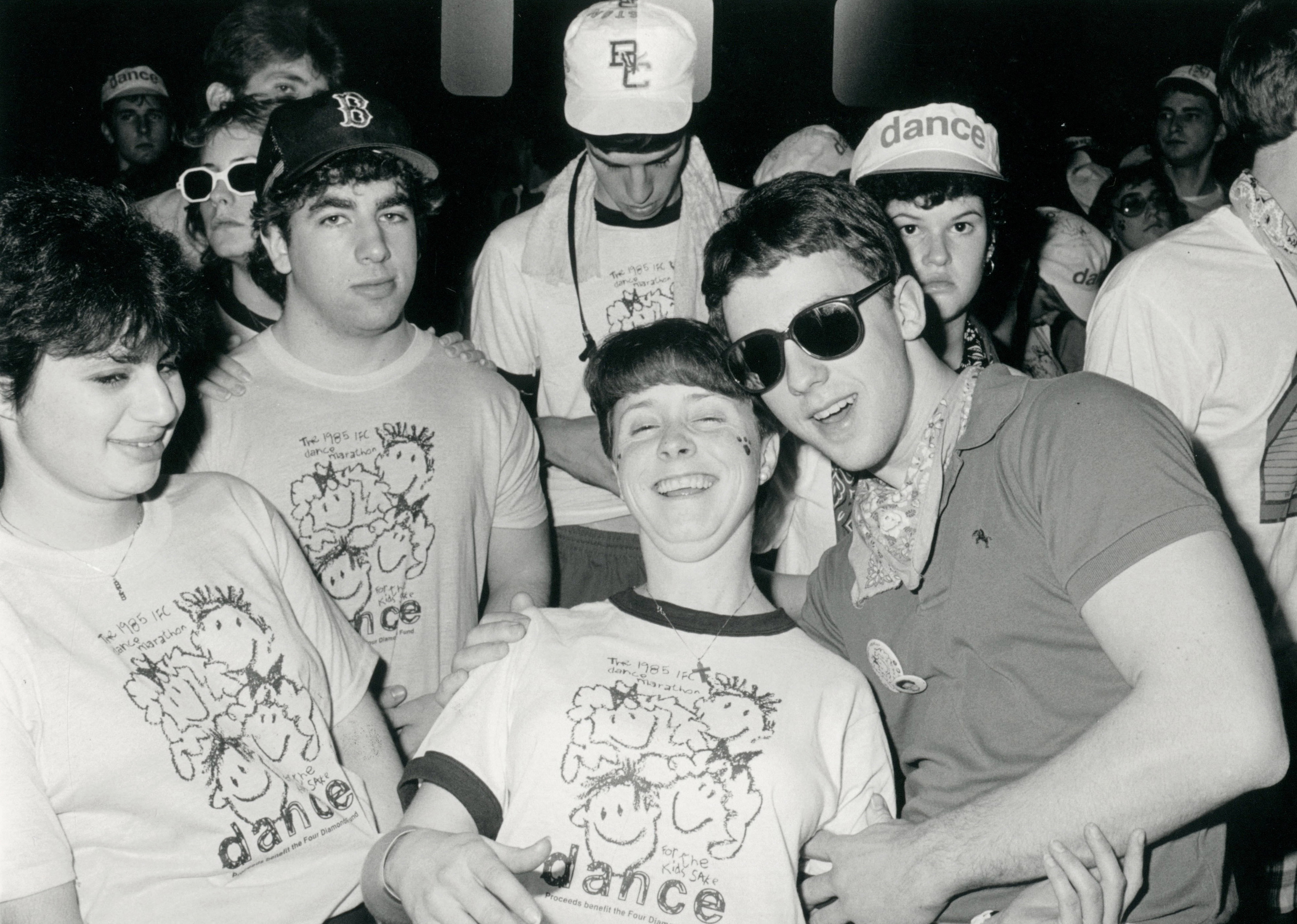
The White Building offered more space, and the number of dancers increased exponentially. By ’82, the White Building gym hit near-capacity with 502 dancers. But for most of the decade, 50–100 dancers would drop out. In 1980, 174 dancers could not finish the full 48.
Schmidt: Before ’79 there was a real focus on people dancing. Rules and Regs walked around with clipboards, and you had to keep those feet moving. You were judged as much on how much you moved as how much money you made. When they moved to White, the focus became more about staying up—which was still very hard to do.
Rzucidlo: We had Rules and Regs, and we told people they had to keep moving. But it wasn’t like we were trying to make it a blood sport at that point. We never kicked anyone out. A lot of people just didn’t make it. I can remember people getting hallucinations. One thing I remember my freshman year is the Phi Psi dancer just ran out an hour before the end. They were gonna finish second, if he had stayed.
Adisey: We tried to help the dancers survive. We had people going out and giving leg rubs and keeping the dancers going. We worked hard at doing that. It was a great feeling.
The first organized year for Morale Pals, later dubbed Moralers (and, much later, Dancer Relations), was in 1979, when 250 volunteer Pals kept dancers’ spirits up, helped with cleanup, and sold balloons as a fundraiser.
Reich: Some people would lose their partner—their partner would drop out—so a Morale Pal would step in and be their partner. And then trade out and have another one, another one, another one, to get that dancer to the end.
The morale committee also planned themed hours to keep dancers engaged. Their first was a New Year’s Eve party at midnight Saturday of the ’79 marathon, complete with party hats, horns, and a rowdy rendition of “Auld Lang Syne.” Eventually, Moralers were leading several themed hours throughout the weekend. Every Moraler was assigned to a specific couple and worked in shifts to keep their dancers awake and motivated.
Beth Gruber ’89 H&HD: When I was on Morale we would give little surprises and presents for our dancers. I remember being able to leave cards and notes in their cubbies.
Philip Kurland ’90 Bus: Moralers were great. Anything you needed, they’d help you get it. I had a high school friend at University Park, and at one point I said, “It’d be great if I could see him.” Our Moralers went out and found that guy!
Moralers would eventually be in charge of leading the line dance, which morphed from its disco roots to a different song and choreographed dance each year.
Mike Richardson ’81 Bus: We did it in ’81 to “Celebrate” by Kool and the Gang. We would each pick a song for our year and do a dance.
Rzucidlo: This is funny to think of now, but in ’85 we wanted to use the old ’60s song “Dance to the Music,” but nobody could get a recording that sounded OK.
Pat Dugan ’88 Bus: In ’88 it was “Free Ride.” I was horrified that I had to get up and dance.
Gruber: In the ’80s the line dance was just the song, and dance moves. You learned the dance to the song, but there were no made-up words. And it was done every hour.
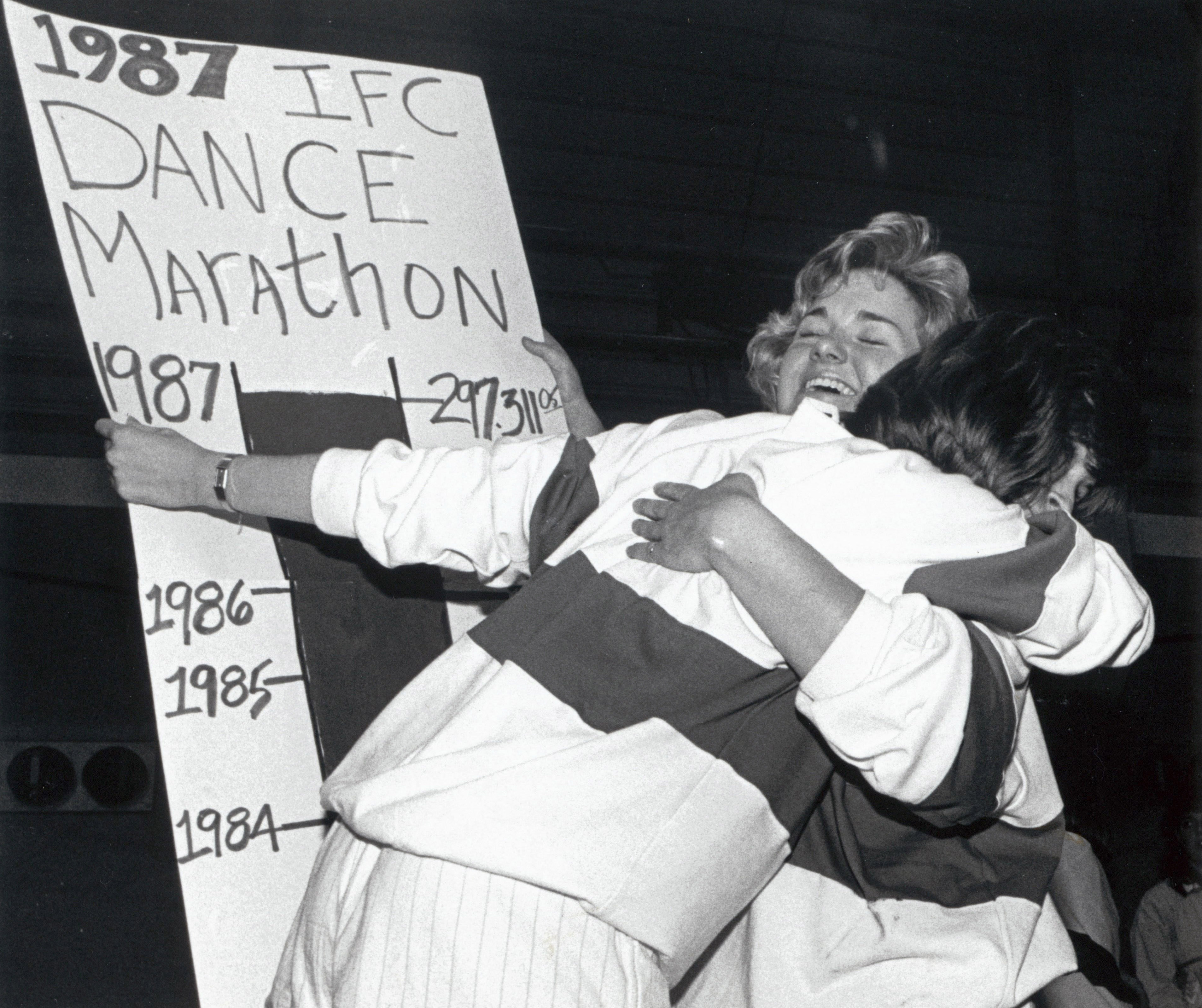
In 1983, Dance Marathon broke into six figures, raising $131,182. That was followed by $179,280 in ’84, and $226,508 in 1985—a record-breaking year that made a big name for itself before and during the weekend.
Rzucidlo: In ’85, we got a 20-second clip on Good Morning America about THON. All they said was something like, “The world’s largest student-led fundraiser starts tonight,” but we were so pumped, just to get that on the national stage. My parents never knew what I was doing, and they saw me on the news in Pittsburgh and were like, “Wow!”
Dugan: They’d always had a final band that was your last hour or two. And the final band in 1985 was Otis Day & the Knights from Animal House.
Rzucidlo: Getting Otis Day & the Knights went over really well. THON always focused on local and regional bands; we were trying to bring in somebody big. We had to rent additional lighting, there were some difficulties in meeting their needs. But it was fun and memorable. It created quite a buzz.
In 1986, Rick Funk began a 10-year stint advising Dance Marathon’s overall committee as part of his job as adviser to the Interfraternity and Panhellenic councils; he worked to strengthen ties between students and Four Diamonds Fund families. In 1987, the IFC Dance Marathon reached $1 million donated to the Four Diamonds Fund since their partnership began.
Funk: That first year I was involved they raised $297,000, and I thought, “Oh my God, we’ll never beat that.”
Dugan: Kids from Four Diamonds and their parents had free rein. They would come back year after year and play with the dancers, play with squirt guns and balloons.
Funk: In the late ’80s we started having families assigned to a group or groups. To me, it was important because so many times everything in a student cycle is one year. You’re president of IFC for one year, overall chair for one year. This way when freshmen or sophomores joined an organization, they got to meet a family, and they could see the benefit of what they were doing. They would connect with their families outside of THON. They’d go to their houses. Sometimes they went to funerals. But that didn’t break their resolve.
John Ferenchak ’92 Bus: You got close to the family. They came out and supported us when we were canning, and then at the marathon we were seated with them. That inspiration was apparent, and we had deep care for them.
The creation of the marathon’s annual themes and logos also shifted during the White Building era.
Rzucidlo: The overall committee would come up with the theme and then put out the contest to the student population, who would submit ideas for the logo. I thought ’84 was pretty cool. The ’85 logo was really simplistic, on purpose. It was four kids smiling, and the theme was “For the Kids Sake.”
Funk: I always took the overall committee to Hershey on a Sunday in the fall. We’d pile into a van and go down and spend the day, get a tour of the Four Diamonds facilities, and have a picnic with Four Diamonds families. On the way back, they couldn’t get out of the van until they came up with a theme. One time I had to drive around Boalsburg for a while when we got back, because they were having a hard time.
Dugan: Every year there’d be an individual logo and slogan, and that was fine for the students. But it was really hard for the businesses and sponsors who were supporting the event. When people would say, “This is the Interfraternity Council Penn State Dance Marathon,” or they’d use that year’s theme and logo, businesses—especially ones that weren’t local—they didn’t know what this was. I got this idea from seeing the United Way logo with the hand and rainbow that was consistent from year to year. So I said, “We need to have a corporate logo.” Back then we would have a spirit week leading up to the actual 48 hours, and the students would work with businesses on College Avenue and decorate their windows. I remember “Thon” used in those decorations. I remember people using it in their notes and correspondences.
Funk: It was referred to as “Thon” in ’87, Mark Miskie ’88 Lib sort of started it, but it really took off in ’88. That was the year they designed the logo; it hung behind the stage for years. I wasn’t crazy about it, but it just seemed to catch on.
Dugan: It just got easy to say, “This is THON.” There was a woman on the marketing team that year, and she’d done a year of graphic design before college, so I showed her a Diet Pepsi can with the lines on the logo and suggested she create something like that. I think they call it the “shuttershade logo.” I kind of can’t believe it hasn’t been updated.
Another name change occurred in 1990, when the Panhellenic Council was formally recognized as a co-sponsor of the event, which became the IFC/Panhellenic Dance Marathon. And in 1991, graphic design students began collaborating with the THON executive committee to design the annual logo as a class project.
Funk: The committee would present the theme to the class, and then the class would come up with designs. Before that, somebody on the committee or another student would have some artistic ability and they’d do it. But the graphic design teacher’s philosophy was “less is more,” and that helped. There were some years where the theme was very long.
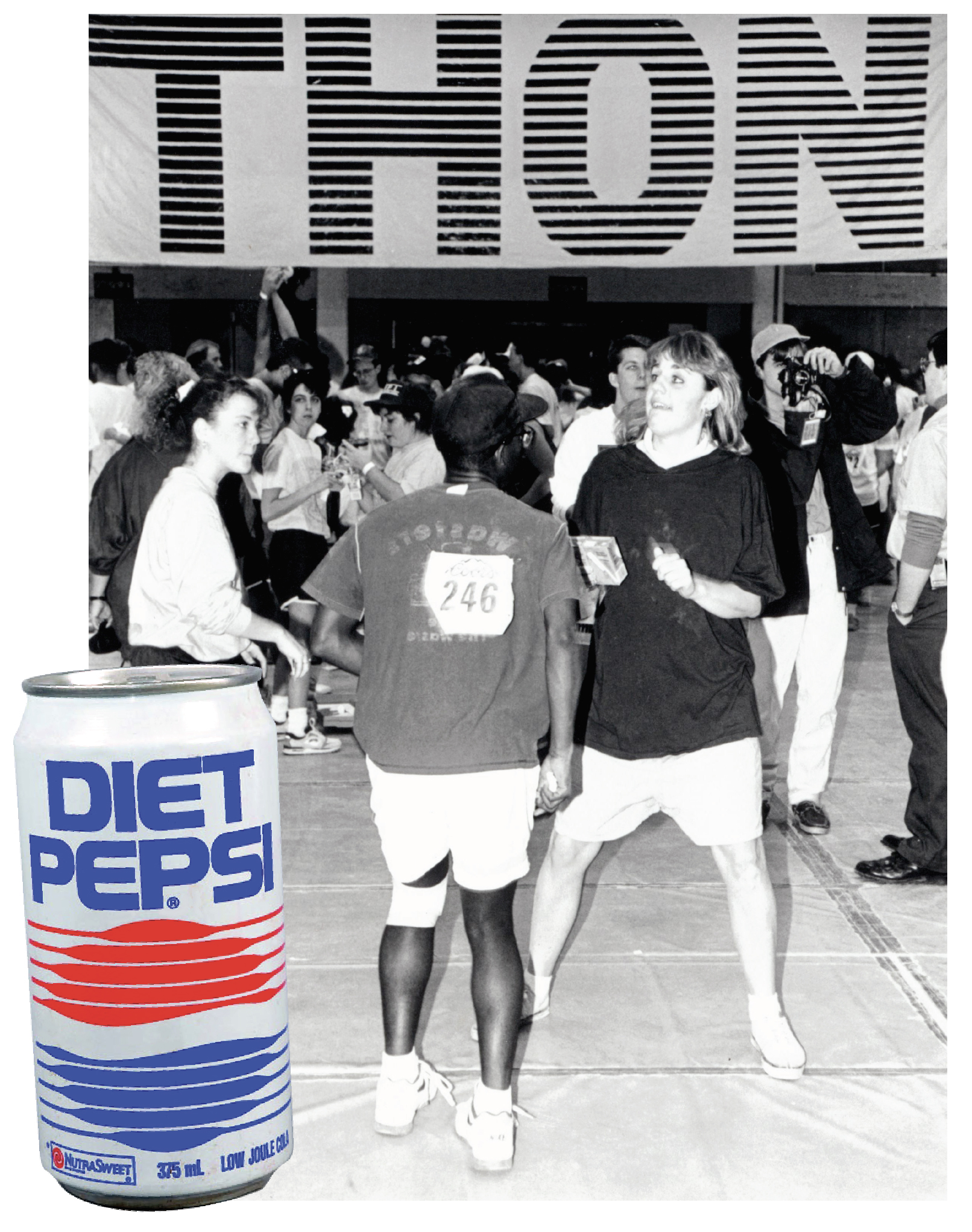
By the late ’80s and early ’90s, students took fundraising to a new level through corporate sponsorships and in-kind donations. In 1988, THON’s social committee became the first to get every food item for the dancers and Four Diamonds Fund families donated.
Gruber: When I was a sophomore I was a social committee member, and I learned about how we went about obtaining all the food for THON. A significant amount of food was purchased. I was like, This is ridiculous. This is a charity. There’s no reason why we can’t get all the food donated, so that all the money goes to the kids.
Dugan: Beth really hustled and made it happen, and the whole cost of feeding everyone disappeared.
Gruber: Fraternities and sororities were involved with the food. We had them making peanut butter and jelly sandwiches, donating supplies from their own kitchens. We got ice pops and yogurt donated. We went to Uni-Mart, every place we could get to donate something. The Creamery donated buckets and buckets of ice cream. We had Stickies and ice cream. Granola bars and bagels. It wasn’t the healthiest diet, but we were just trying to feed people.
Those new fundraising avenues paid off in 1992, when THON hit the $1 million mark for the first time.
Ferenchak: This was before the internet. You had to go bang on doors, you had to go car window to car window. You had to pick up the phone. And we knew how to do that at my fraternity, Pi Kappa Phi. So when I became overall chair for the ’92 THON, I went on a THON Road Show, inviting satellite campuses and every student organization at University Park to learn how to secure a permit for a canning corner, how to create a sign that’s simple and gets drivers’ attention, what’s your pitch for a phone call solicitation. It was about educating and empowering student groups.
Funk: They used to count the money throughout the weekend at the THON office in the HUB. And that year, the overall finance person came over to me on Sunday afternoon and said, “Rick, I think we did it.” So I left the White Building after Family Hour, went to the office, and double-checked the numbers: $1,141,145.
Ferenchak: I didn’t know until 20 minutes before the end. I’m backstage, and Rick comes up and his face is very stern, he almost has this ashen look, like he’s in shock. He says, “I’ve got the overall tally.” He hands me this piece of paper, doesn’t say a word. I unfold it and see the first digit is a “1.” I look at him, and he looks at me, and we’re both in shock.
Funk: I went and got the Nittany Lion, and he stayed back behind the stage with us for the reveal. Tradition was that the overall committee members each held up cards to reveal the total, and I knew once they laid the number cards face down on the stage, people would be counting how many we laid out. So we had the Lion with the dollar sign hiding behind us, and we added a comma by one of the numbers on one of the cards. So it looked like six digits instead of seven.
Ferenchak: Usually after the dancers sat down, you’d announce the top money-raising organizations, and then the grand total at the end. This was such a monumental number, I wanted it to be a Penn State celebration. I wanted it to be the inclusive number first. I remember saying “One…” and then I couldn’t hear myself speak. It was like the roof exploded.
Funk: What I remember the most is—I’m getting chills now thinking about it—he said “One—,” there was sort of a hush, and then it just erupted. They knew they had done it. It seriously was one of the highlights of my time at Penn State.
Ferenchak: I remember looking at the Millard family at the time. I just remember being able to share that moment with them. They were crying.
Millard: Chris said that if he died, he wanted to come back as a wizard and make people well. And that’s what Penn State did for him.
After that record was broken, THON never looked back, raising at least $1 million every year since. In 1995, a glass ceiling of a different kind was shattered with the selection of THON’s first female overall chair, Stacy Bingler Forbes ’95 Bus.
Forbes: In my interview they asked: “How would you handle being the first female THON overall?” I said, “That’s like asking me how I handle going to class every day, as a female.” I told them if I’m the best one for the job, I’m the best one for the job.
Funk: Expectations had started to build, especially after John’s year. People would start coming in around 1 or 2 p.m. Sunday and just stay. There was so much energy, and the dancers picked up on it. But I didn’t want the focus to be on the money, I wanted it to be on the event and the families.
Forbes: Back then everybody was focused on “winning.” I made a concerted effort to focus on the kids. I wanted it not to be so cutthroat. The year before, they raised $1.31 million, and we raised $1.29 million or something like that. We still raised a ton of money, but I was trying to get the focus away from, “If you don’t raise as much as the year before, it’s a failure.”
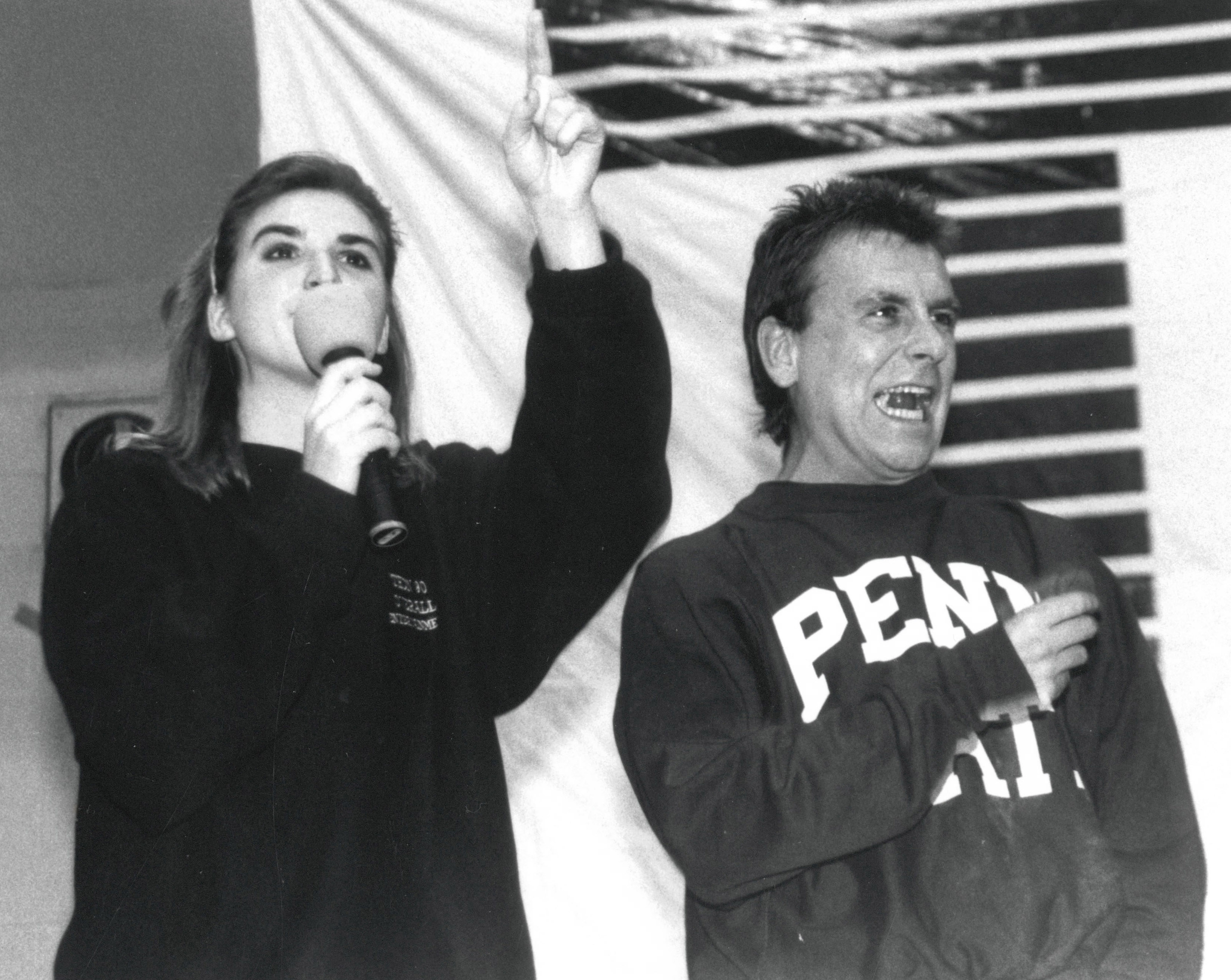
By the mid-90s, a new dancer tradition had been set: Mail Call, which began in 1990 and initially happened the Saturday night of THON. Mike “The Mailman” Herr was invited every year to hand out dancer mail—letters and packages from loved ones and strangers alike, encouraging them to keep going.
Herr: The first time, there was very little mail. My daughters, Marykate and Michaela, and a friend of mine, Rudy Glocker ’91, ’93 MA Lib, who played football, they came with me and we’d call up couples’ dancer numbers, and they’d come up and get their letters. Some couples didn’t get any that first year.
Klein: Mail Call was always a big deal. At that point in the weekend, the crowds were very thin, and that was a tough time for the dancers.
Herr: You could just see how it started to catch on; there was more mail every year. When I was still working at the post office, I really realized that THON was not just those 48 hours. Groups of kids would come in and mail packages to their THON child. And the students who danced, they would thank me for being someone they recognized on stage.
Liz Coppola Fay ’96 A&A: I was a morale captain in charge of Mail Call in 1996, and then in ’97 Parmi Nous was helping with Mail Call. My boyfriend, Chris Fay ’96 Eng, and a lot of my friends put on postal shirts and helped hand out mail. Chris and I had met at THON in 1995. While we were passing out envelopes, Chris handed me a letter that had my nickname from when I was a morale captain: Captain Click. I was completely confused. Why am I getting mail?
Herr: Chris got down on one knee and proposed to her, in the middle of Mail Call! He had a ring and everything. That was so great.
Fay: Larry Moore Productions put up a graphic on the big screen that said, “Congratulations Liz and Chris,” and I spent the weekend with everybody congratulating me.
Larry Moore Productions had begun DJing the marathon in 1991, taking over for longtime music provider QWiK Rock.
Schmidt: I was the station manager at QWiK Rock, which was not playing Paula Abdul and Tone Lōc and all that stuff in 1990 that the kids wanted to hear at THON, so we were having to go out and get all the music. Plus there was a problem with requests: Our DJs were working in shifts, so when volunteers would come in for a shift and morale people would come in for a shift, they’d request songs and the DJs would play them, and the dancers would go, “Quit playing the same stuff over and over again.” That’s when I asked Larry Moore ’79 Bus if he would like to help us. They donated the whole 48 hours. That took a big load off my shoulders.
It was also becoming clear by the early ’90s that THON was once again outgrowing its home.
Ferenchak: Rick and I understood that the White Building was not going to be sustainable. We knew that in 1992. We thought the next logical step was Rec Hall, so Rick took his thoughts to the decision-makers at the time and got rejected because of basketball.
Forbes: We grew out of White Building years before it moved. Every year we discussed it. “Where are we gonna go?” At the time, moving into Rec Hall wasn’t an option. But Rules and Regs were busy all weekend long; the doors had to close a lot because the safety capacity had to be enforced. We were limited on the number of dancers we could fit, so that limited our fundraising ability. Plus the cubbies [for the dancers’ stuff] were tiny.
Brian Newmark ’99 Bus: There was concern about losing the intimacy of the event if we went to a much larger space. We were concerned it would completely change the shared experience of THON. The university suggested the new Bryce Jordan Center, but we started looking at Rec Hall. It had a really cool vibe. I remember meeting with the facilities team there, and it was a logistical challenge. We had to figure out how to move the whole organization.

In 1999, intercollegiate athletics made the necessary accommodations for THON to move to the 6,500-seat Rec Hall.
Newmark: Larry Moore had to figure out how to take what they were doing at White and bring it to Rec Hall, where there was a completely different audio structure, room, and set of requirements. We built a dancer relations booth on the floor for dancers to ask questions about where things were. Sleeping arrangements for committee members were a weird thing to figure out. We slept in shifts on the racquetball courts. I remember when I went to my four-hour sleep shift, I told like seven people, “You better not forget to wake me up!”
Vinny Carrano ’15 Lib: As a Four Diamonds family, I remember being at Rec Hall in 1999. I was still a kid, and my sister Lauren had died in ’96, but the students always did their best to go out of their way to make sure that as a bereaved family we still had a place at THON. I remember part of the line dance that year had the lyric, “Wait a sec, we’re in Rec!”
Newmark: Rec Hall has a track at the top, and I remember standing up there at one point and looking down just completely overwhelmed. To know that you kept it alive and you made it a little bit better, that’s really all we wanted to do.
Despite the overall committee’s concerns, 1999 THON filled Rec Hall with spectators and raised $2.5 million, about $500,000 more than the previous year.
Newmark: The Four Diamonds Fund board approached us that year and said, We’re looking to break ground on this new research facility, and we need to know if you think the students would be open to making a strong financial contribution to this. We talked to our team about it, and our team said, “Yeah, of course.” So we committed $5 million over the next five years. Now there’s an actual structure, and we get to say we were involved in making that.
The Penn State Cancer Institute opened in 2009.
Forbes: I danced in 2000 as an alum, my first time dancing. It was the second year at Rec, and the space was so nice. We had a whole locker for all of our stuff. Way better than the cubbies at White.
In 2001, THON participants attempted to break the Guinness World Record for the World’s Largest Group Hug, with 1,271 people hugging for more than 10 seconds. That year also debuted THON’s first special interest organization, Springfield.
Matt Thomas ’03 Lib: We had this close-knit group of friends in Springfield, the first floor of Simmons Hall, and a passion for THON. We really wanted to be involved, but there wasn’t an obvious path. So we asked if we could just start our own organization for THON, and they said, “Sure.”
Pat Seymour ’04 Lib: It didn’t seem like we were actually doing anything unusual at the time, but it ended up opening a door to another pathway for people to get involved.
Thomas: We went canning and raised a bunch of money, $6,500. I danced that first year—it was dizzying, exhausting. You’re delirious enough to think that you’re sort of part of this larger thing. Which you are.
Seymour: When I danced in 2002, the Four Diamonds family that Springfield was associated with, the girl was fond of SpongeBob SquarePants. My co-dancer’s name was Bob, and he got “SpongeBob” on the back of his shirt. So I have a shirt somewhere in a drawer that says “SquarePants.”
From 2001 through 2021, Springfield’s members raised more than $2.6 million for Four Diamonds and inspired the creation of more than a dozen other special-interest organizations dedicated to THON.
Thomas: We get these Springfield alumni emails, and there’s a website now; it’s been surprising to see how much Springfield has grown. We never would have guessed there’d be so many other organizations like it popping up.
In 2002, cast members from MTV’s The Real World and Road Rules 10 shows visited THON. That year there were 700 dancers and 200 committee captains leading volunteers. Plus, 73 Four Diamonds Fund children had their Penn State wishes granted as part of the first Penn State Wish Program during THON weekend.
Millard: I was in the dining hall where they had the meals for Four Diamonds families, and some little kid, about 9 or 10, came up and said, “It’s because of you that I’m here.” It floored me. I looked at him and said, “Have a great life.”
In ’04, THON pledged $10 million to create the Pediatric Cancer Pavilion at Penn State Hershey Children’s Hospital. They exceeded their goal within three years, as THON’s new home accommodated more dancers and donors than ever before.
Herr: One year at Rec Hall, Mr. McFeely [actor David Alexander Newell] was there from Mister Rogers’ Neighborhood. He didn’t help with the mail, but I was on stage doing Mail Call, and then he came out and people wanted his autograph. One kid came up to him and said, “I don’t really know you, but my mom does; can I get your autograph?”
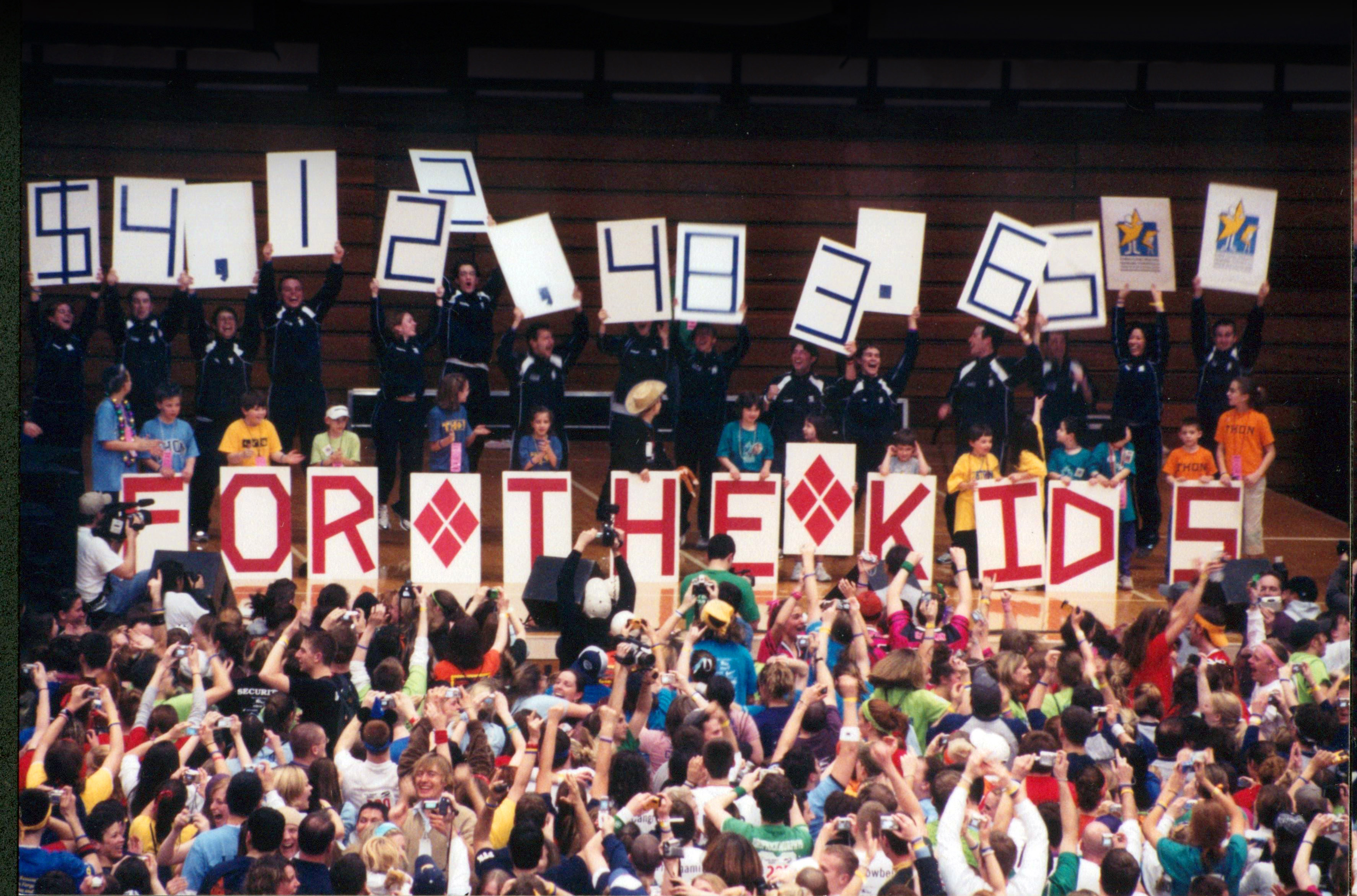
In the 2000s, technology began to play a major role in spreading the message and magic of THON.
Newmark: We got to do a lot more creative stuff with video cameras when we moved to Rec Hall. There was a company that was going to try to livestream us—I know we tried to do it in ’99, but it didn’t work great. But we had two giant projection screens on the stage to use, where in the old days there was only one screen.
Schmidt: The internet was just getting going. They started to broadcast THON live, and that was not without its challenges. The bandwidth wasn’t that great in the early years.
Evan Jacobs ’06 Lib, ’06 Lib: I was chair of Rules and Regs in ’05, and our biggest issue was we were at capacity. We tried to figure out the best ways to fairly let people on the floor. That’s when we started using an electronic pass system, so we could monitor who could get on and off. There was also a new position in ’05, the technology chair. And by ’06 we used a full electronic system where we were tracking people on and off the floor. And that’s been used since.
By the middle of the decade, THON committee members started negotiating with university administration to move once again, to the Bryce Jordan Center.
Michael Funk ’07 Eng: The NCAA had to give us blackout dates. This was the first we really were relying on the university to be able to do what we needed to do.
Jacobs: They certainly had their doubts. From my background in Rules and Regs, I was worried about fire code. We didn’t want something to happen that would end THON because God forbid there was some type of emergency.
Al Karosas ’95 H&HD, BJC general manager: We went to visit the last THON at Rec Hall in 2006, to figure out how we could reshape it and fit it in the larger facility.
When Jacobs was overall chair in ’06, an agreement was put in place for the move across campus to the BJC, the largest indoor facility at University Park. There was just one sticking point, which his successor, 2007 overall chair Michael Funk, still had to settle.
Funk: I met with President Graham Spanier to go over everything, and he said, “OK, so I need you to cut the hours.” He said he thought THON was too long. I held my ground and said, this is a student-run philanthropy, but I brought the idea back to the committee. He initially wanted to cut it to 36 hours; he cited safety concerns and dancers dropping. Not more than a couple dancers were dropping out by this time, but in his mind THON was too long. We went round and round, and ultimately, I said, “We’ll give you two hours.” That’s how we landed at 46.
Jacobs: I think ultimately, as they are with THON, the administration is very deferential to the students, and [they] try to support them the best they can.
With help from the BJC staff, Funk and his overall committee started planning for the transition, with a big assist from ’06 special projects overall chair Megan Collins Wilson ’06 Lib and ’07 OPPerations overall chair Bill O’Tormey Jr. ’07 Lib, ’07 Lib.
Funk: We all knew THON in Rec Hall. But what does that look like in the Bryce Jordan Center? They invited us to a WWE wrestling event; they had us come for when they did the event setup, and we stayed afterward for the teardown, so we could see how they did everything.
O’Tormey: What people don’t see is what goes on behind the scenes with THON. BJC does not have the backstage footprint that Rec Hall had; there was lots of ancillary space in Rec Hall: The captains there all weekend have sleep spots, there’s a family lounge, other staging areas, locker rooms for dancers, a kitchen for meal prep. We didn’t have equal space. So we had to take the new blueprint and figure out how to capitalize on the space we had.
Karosas: We were able to match everybody up with someone on staff, and that was extremely successful. We matched up their hospitality overall with our director of food and beverage, and their Rules and Regs overall with our event manager, who could show them things like, This is how you get people into the building; this is how you’d evacuate.
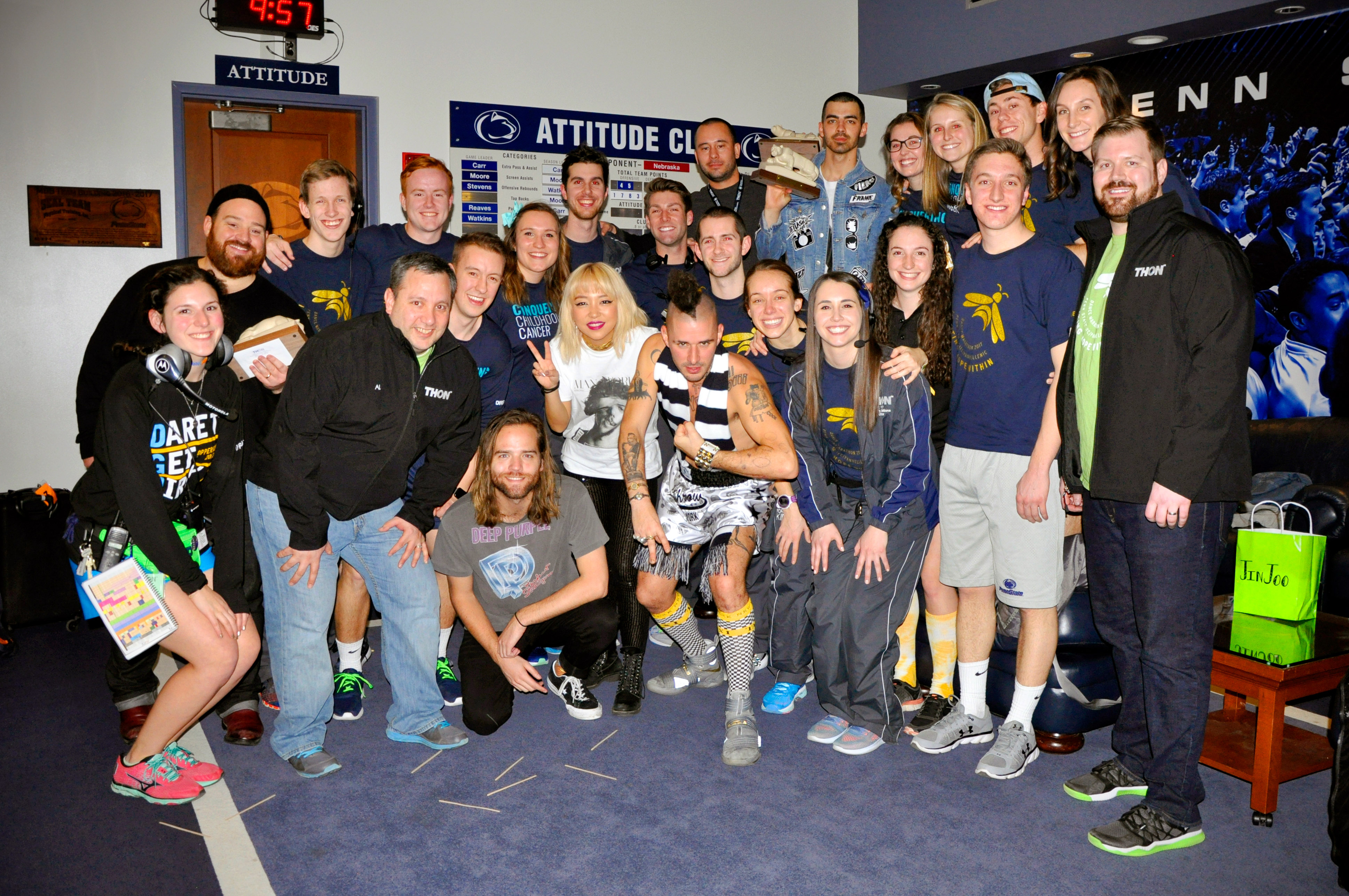
For THON’s first year at the Bryce Jordan Center, O’Tormey oversaw 20 OPPerations captains, who in turn led 500–700 student volunteer OPP committee members to help pull off the event in its new digs.
O’Tormey: I was a fifth-year senior, and I truly stayed that fifth year because I wanted that challenge. I wanted to take it to the new building, knowing we were going from 6,000 capacity at Rec Hall to 16,000 at BJC.
Karosas: They went to a completely different operation: 10,000 more seats, additional locker room spaces, different scoreboard and video capabilities, and a staff that sets up and tears down for people like Garth Brooks and Billy Joel. And in Year 1, they used every square inch of this building.
O’Tormey: We used to have Thursday all day and night, and all of Friday, to get into Rec Hall and set up. But there was a basketball game Thursday at the BJC, so we didn’t get in there until 2 a.m. Friday. We were already starting THON an hour earlier, at 6 p.m. instead of 7 p.m. When the dancers were walking in, I did not feel like we were 100% ready.
Funk: My biggest fear was: What if it doesn’t feel like THON anymore? What if it’s empty? Everyone was so used to being packed in like sardines in Rec Hall and having to get there early before they were at capacity. The upper bowl of the BJC has black curtains to drop down, and they were down when we started so you couldn’t see empty seats. But by Saturday afternoon, if not sooner, we were at capacity for that lower bowl. And I’ll never forget when we got to make the call to the BJC staff to raise the curtains. It was unbelievable. We got the whole upper bowl filled, too.
O’Tormey: We had the fear that at the end people were gonna keep standing, that there might be dancers who won’t sit. We had contingencies in place for how to handle that. But after 46 hours on their feet, I don’t think any dancer was looking to make any sort of statement.
Funk: There was definitely disappointment from previous generations of THON with the 46-hour announcement. But once the first year happened at the BJC and everyone saw how magical it could be, I think that pushed it to the background. The focus is not on dancing 48 hours, the focus is on the kids. Everything we’re doing is for the kids.
THON’s first year in the Bryce Jordan Center exceeded all expectations in terms of attendance and fundraising, breaking another record with $5.2 million.
Funk: By noon Sunday donations are still coming in, but in order to prepare for the announcements you have to cut it off and add things up. My finance overall Kate Rippe Dowd ’07 H&HD and I sat and went through all the different tabs and had the formula ready, and on a count of three, we hit “enter.” The number came out and we screamed and fell out of our chairs. For the next four hours, we had to keep that between the two of us. It was an amazing feeling—we beat the old record by a million dollars. It was great announcing that total. I have a picture someone took of us all on stage with my arms wide, looking like an idiot.
Four Diamonds child Ashley Fazekas’ first THON was in 2007. Diagnosed with acute lymphoblastic leukemia in 2006 when she was just a year old, Fazekas was paired with the Penn State Lionettes and got to spend time with them on the floor of the Bryce Jordan Center.
Fazekas: I remember when I was 2 my organization, the Lionettes, gave me a quilt, and I still have it. And one of the girls from my first THON, I’ve gone on trips with her.
Fazekas underwent her last chemo treatment in 2008 and is considered cured. The high school senior hasn’t missed a THON since her first.
Fazekas: They call me a $3 million Four Diamonds child. That is pretty common for cancer kids, because all those years of treatment and pills, it just adds up. And Four Diamonds covers all cancer-related medical costs; I’ve had a lot of health issues from having chemo when I was so little.
2008 saw some changes in entertainment, with a new spin on the Pep Rally that had Penn State athletic teams performing choreographed routines, and a new band in the THON live music rotation—Go Go Gadjet—that would eventually become THON’s go-to closing act.
Jeff Tomrell ’06 Bus, Go Go Gadjet: In 2008, we were performing every Wednesday at Café 210 West, and we got an email that said, Would you like to participate in THON? My motivations at that time were not centered around “For the Kids.” I was thinking, “We get to play in front of all these people!” Our slot was Saturday afternoon, and we had to keep stopping our set so they could make announcements. Nobody knew Go Go Gadjet, and nobody cared. Half the dance floor left at one point after they announced a cookie decorating competition. I got frustrated. Then as soon as we finished, it hit me: This isn’t about us at all. Year 2 we got to play from 10 to 11 a.m. on Sunday, which was a completely different environment. Everyone knew the end was approaching, and we came in with a different mindset. I remember that morning being like, “That was one of the most fun things I’ve ever done in my life.” From Year 3 on we’ve been the last hour.
THON’s finale begins with an emotional Family Hour, during which Four Diamonds families past and present take the stage to share their stories. That’s followed by one last line dance with all the dancers, volunteers, and anyone else on-site who has learned it, and then the final hour of live music before the total is revealed.
Carrano: The first year I danced, in 2012, they had me speak at Family Hour, which had been a thing for as long as my family had been going to THON in the ’90s. [My sister] Lauren died right around THON weekend in 1996; she only went to one THON, but when I am at THON is when I really feel closest to her. I really don’t know what the entire experience as a family would have looked like without THON. So many families [fighting cancer] don’t have that support system, they don’t have that shining light, that silver lining.
Tomrell: I made the mistake once of standing and watching the full Family Hour before our set. Then we got on stage and I was so choked up I couldn’t sing.
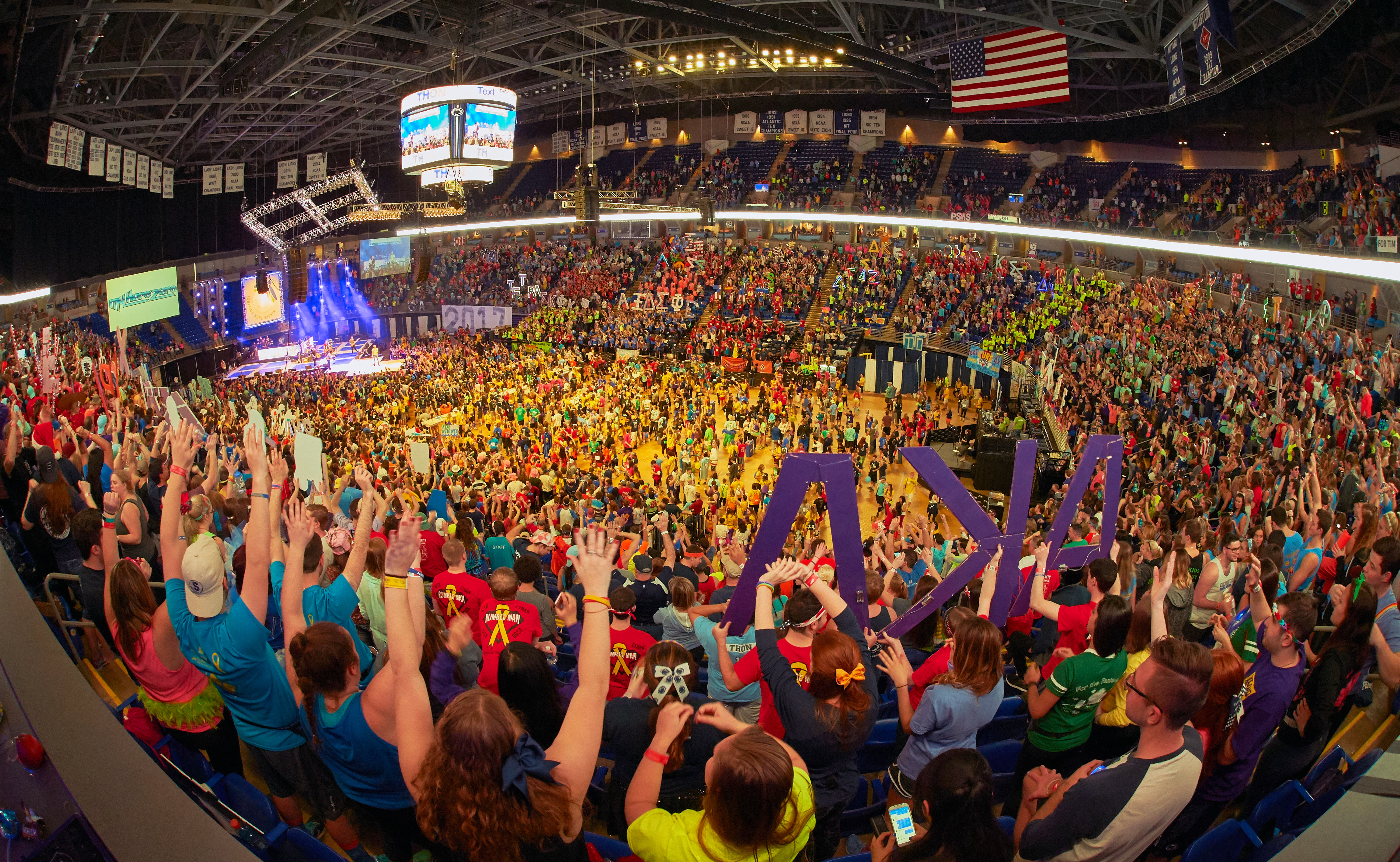
Elaine Tanella '12 Eng, the overall chair in 2012, and her committee leaned into emerging tech-based fundraising trends, including text-giving, and enhancing THON’s online donation portal.
Tanella: Social media was taking off, so we got more active on Facebook starting to share photos, and increased the size of our audience. And we started to have more THON nights at games for various sports.
Their efforts paid off, as THON crested the $10 million mark for the first time.
Tanella: Being a student in 2011 and 2012 was challenging in general. There was anxiety that the Sandusky scandal would dampen the efforts and the hard work of the students. But it didn’t dampen our spirits, and we didn’t lose support.
In 2014, the “overalls” became “directors,” as THON committee members tweaked their titles. Then, after years of planning, the THON Store at the HUB opened in time for THON 2015.
Carrano: My senior year I was a merch captain, and we were the group to finally open the THON Store. We would design and order and manage all of the merch—every THON shirt at THON weekend, all that came through us.
In spring 2016, THON announced a phased end to canning in 2017—the same year a surprise set from Joe Jonas and his band DNCE raised the bar sky-high for celebrity guest appearances at THON.
Karosas: All their road cases we were setting up the night of the event, we taped over where it said “DNCE” so nobody had an idea what we were loading in. We did the sound check with everybody but Joe and two of the key band members. And we brought them through a special entrance, in Jordan Center attire, so no one really noticed them. It was a lot of cloak-and-dagger; maybe four or five people knew about it.
Fazekas: I got to meet Joe Jonas that night, which was awesome. The Lionettes have good hookups, so I ended up getting to stand backstage and wait for him and talk to him.
Karosas: I said, “Hey Joe, when you’re done playing, do you mind meeting some of the THON families?” He said, “Tell me what I need to do.” You get few moments like that when you feel extremely rewarded for incredibly hard work.
The Bryce Jordan Center hit capacity before the THON Pep Rally that year, which got a burst of Penn State pride in 2019 when the Alumni Association partnered with THON for the Pep Rally White Out, surprising spectators with 12,000 white T-shirts during the rally.
Jacobs: It’s crazy to think that they’re closing the doors early at the BJC. I don’t know that we ever imagined we would totally fill the Bryce Jordan Center.

The only time THON hasn’t filled the BJC to capacity since the mid-2010s was in 2021, when a pandemic created the need for the first Virtual THON.
Katie Solomon ’21 Lib: By the summer of 2020, we knew it was not going to be in person. We decided to make the announcement before start of fall semester; that way expectations were set from Day 1. I could not sleep for weeks, the fear and uncertainty of wondering, Are people gonna still want to do THON? But all of that was washed away the moment we made the announcement. I was flooded with texts and emails from old volunteers, employees, Four Diamonds families saying, “We think this is a smart decision. We stand by you.” It was a wave of support.
In the end, 592 dancers—about 125 fewer than in a typical year—signed up to dance in their dorm rooms and apartments while watching a livestream of entertainment, music, and slightly tweaked THON traditions.
Solomon: The dancer experience had to be completely rethought. The messaging behind it was: When you’re a THON dancer, you’re showing strength and solidarity with Four Diamonds families. You don’t need to stand on your feet for 46 hours to show you’re a dedicated THON volunteer.
Dancers were encouraged to take breaks from midnight to 6 a.m., and volunteers worked double time to make sure the livestream stayed lively. Varsity sports teams prerecorded their pep rally performances. A full slate of bands performed. And more family stories were showcased than ever before.
Solomon: Everywhere THON wasn’t in the Jordan Center, it was dispersed across the country. We had viewership in 70 countries. We had 165,000 unique viewer logins to the livestream, and no one was watching alone.
Solomon and her team sobbed when donations were tallied: $10.6 million had been raised, under unprecedented circumstances, for Four Diamonds.
Solomon: In all of the years I was a THON volunteer, THON 2021 is the closest I ever felt to the mission.
THON 2022 executive director Kate Colgan and her team are taking the best of last year’s THON—including peer-to-peer online giving through DonorDrive, and hybrid events that include virtual livestreams—into THON’s 50th year.
Colgan: This is a turning point for the organization. “Doing as much as we possibly can” is the goal. We’re planning a bunch of things to recognize the fact that it is the 50th THON.
And it will honor Charles Millard, who died Nov. 4, 2021, at 93. He had attended nearly every THON since 1976.
Millard: It’s hard to pick one THON as special; they’re all really special. It’s what many, many thousands of people did that made this happen. And I think Chris would approve.